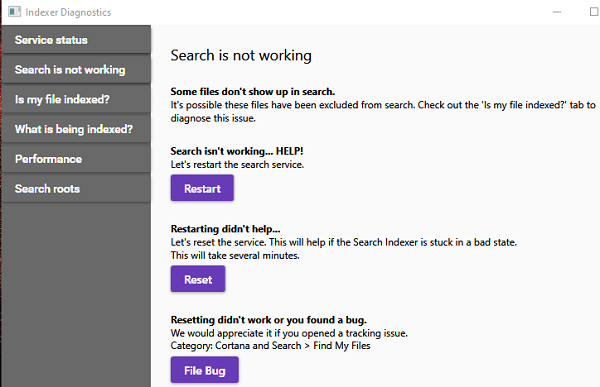The Windows Search Indexer is a service in Windows 10, which makes sure to find a file or content inside when you ask for it. But like any other Windows service, it's not without problems. Sometimes this results in high CPU usage; sometimes it just doesn't work. Microsoft has deployed the Indexer diagnostic tool, which can identify problems and issues related to Windows search indexer.
Microsoft Indexer Diagnostic Tool
When you launch the diagnostic tool, be ready to be impressed. It's not just another Microsoft repair tool, but a well-made app! On the left, you have the following menu:
- Service status
- Search does not work
- Is my file indexed
- What is indexed?
- Performance
- Research tools
It offers many tools to check the problems that Windows search often faces. When you are unable to find a file or the service is disabled, you can find a solution using this application.
Identify problems with Windows Search Indexer
1) Service status
This is the dashboard where you can find out the number of indexed files, the list of indexed drives, Outlook items and Microsoft Edge history items. You can filter usage by the last hour or the last day or the last week. You can also see the search service status and version.
2) The search does not work

If Windows 10 search does not work, this section guides you to fix them. He understands issues like Search does not work, The reboot did not help, Reboot did not work due to a bug.
3) Is my file indexed

If any of your files do not appear in the search results, you can check the status here. The diagnostic tool will help you identify the exact problem. For example, in the image above, the advanced attributes of the file have a problem. The rest of the checks are for file existence, scope, pending URLs, indexer query and much more.
4) What is indexed?

It lists the drives and folders, which are included for indexing and the paths that are excluded. You can manually add folder paths to each of them.
5) Performance
The indexer diagnostic tool displays the number of failed / successful queries in Windows. With it, you will see:
- Resource tracking if the search indexer uses too many resources
- Functional tracing and collection of application logs that will help solve the problem
- The File Bug button allows you to submit an entry using the Feedback Hub
6) Look for the roots
This is only information and indicates where the indexer will start its search.
Indexing problems are very common, and this tool should make it easier for anyone to solve the problems and also solve them. It is available for download here in the Microsoft Store.
I hope the tool will help you fix Windows 10 indexing issues.
